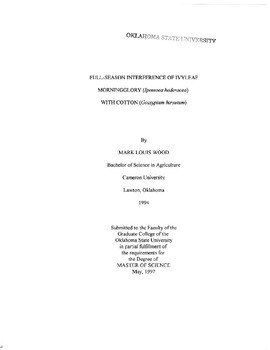| dc.description.abstract | Approximately 154 thousand hectares of cotton were grown in Oklahoma in 1995, or that area, approximately 4,800 hectares were infested with morningglory species, and those weeds caused a 14% yield reduction when present (Byrd 1996). Yield losses for morningglory can be attributed to the growth of the vines throughout the crop canopy and to the trailing ability of the plant to spread. Previous reports have noted that morningglory can cover a crop by growing upward and outward, causing cotton to grow abnormally, creating difficulty in machine harvest (Buchanan and Burns 1971; Crowley and Buchanan 1978; Rogers et al. 1996). Dowler (1995) reported that morningglory species ranked as the third "most common" and fifth "most troublesome" weed in Oklahoma cotton production. Several factors contribute to those rankings: 1) common PPI or PRE herbicide applications do not effectively control morningglories, and some herbicides, that do control it cannot be used safely on sandy soils; 2) if the weed emerges and is not controlled by PPI or PRE treatments, it is likely that it will be present in the crop for the entire season; 3) cultivation does not control weeds in the row and; 4) and POST directed spray applications are rarely used in Oklahoma. Buchanan and Bums (1971) reported that, eight tall morningglory [I. purpurea (L.) Roth] plants 7.3m-] of row reduced picker-harvested cotton lint yields 10 to 75%, in Alabama. Crowley and Buchanan (1978) reported on the competitiveness of four Ipomoea spp. and their effects on picker-harvested cotton in the same state. Species tested included tall morningglory, entire leaf morningglory (l. hederacea var. integriuscula Gray), ivy leaf morningglory, and pitted morningglory (I. lac1I1'1osa L.) at densities of 4, 8, 16, and 32 plants 15m-l of row. At the eight plant density, cotton lint yield was reduced by those species 19, 9, 6, and 3%, respectively. Harvest efficiency was reduced by tall morningglory with each increasing density, but no other morningglory species caused harvest efficiency reductions. Rogers et al. (1996) conducted research in Oklahoma to measure stripper harvested cotton lint yield losses from seven ivyleaf morningglory densities at two locations; the densities used were similar to those of Crowley and Buchanan (1978). Data from Rogers et al. (1996) fit a linear-linear (or piecewise regression) model as described by Neter et al. (1985). The first linear component "broke" at a an estimated joint of 8. 7 and 9.0 weeds 10m(upper)-1 of row at Perkins and Chickasha, respectively. Reported yield reductions for each increase of one weed 10m(upper)-1 of row were 36.9 and 29.7 kg ha-I for densities up to an estimated 8.7 and 9.0 weeds 10m-I of row at Perkins and Chickasha, respectively. Data converted to a percentage of the check demonstrated for each increase of one weed 10m-I cotton lint yield reductions of 5.9 to 3.9% at weed densities up to an estimated 10.0 and 11.4 10m(upper)-1 of row for Perkins and Chickasha, respectively. At Perkins, densities greater than 16 weeds J Om-I of row could not be mechanically harvested. At Chickasha, densities greater than eight could not be mechanically harvested. Plots that could be mechanically harvested demonstrated no significant differences at either location. Determining the effects of full-season interference over moderate densities of ivyleaf morningglory on stripper-harvested cotton would provide Oklahoma producers a way to decide how much of their efforts should be allocated to control of this species. Therefore, the objectives of this research were to measure the effects of such interference by seven weed densities on cotton lint yield, stripper-harvest efficiency, and fiber quality properties, and to develop prediction models for them to compare with those constructed previously by Rogers et al. (1996). | |
